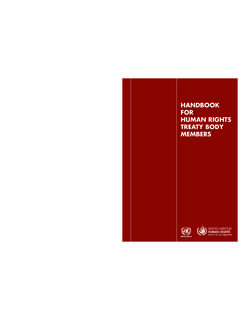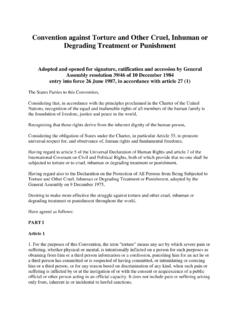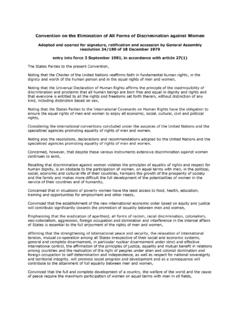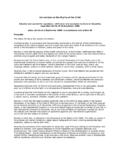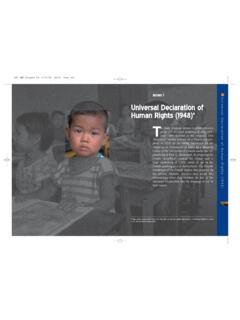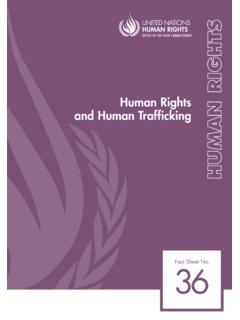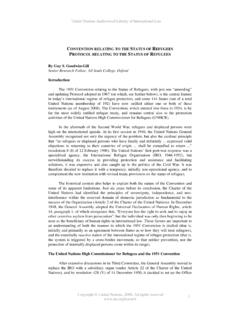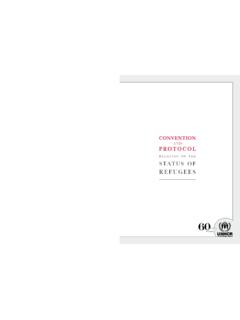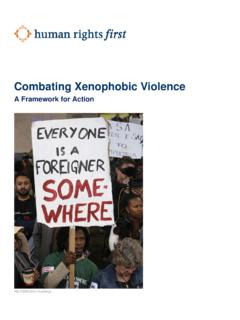Transcription of Fact Sheet No.20, Human Rights and Refugees - ohchr.org
1 Fact Sheet , Human Rights and Refugees Contents: Introduction The united nations and Refugees International refugee law/Other international instruments Human Rights and Refugees Violations of Human Rights and Refugees Conclusions Annexes: - Convention relating to the Status of Refugees - 1967 Protocol relating to the Status of Refugees Introduction The problem of the world's Refugees and internally displaced is among the most complicated issues before the world community today. Much discussion is taking, place at the united nations as it continues to search for more effective ways to protect and assist these particularly vulnerable groups. While some call for increased levels of cooperation and coordination among relief agencies, others point to gaps in international legislation and appeal for further standard-setting in this area. Everyone, however, agrees that the problem is both multidimensional and global. Any approach or solution would therefore have to be comprehensive and to address all aspects of the issue, from the causes of mass exodus to the elaboration of responses necessary to cover the range of refugee situations from emergencies to repatriation.
2 In this debate some facts remain beyond dispute. The first is that while some mass displacements may be preventable, none are voluntary. No one likes or chooses to be a refugee. Being a refugee means more than being an alien. It means living in exile and depending on others for such basic needs as food, clothing and shelter. Information on the number of the world's Refugees , their geographical distribution, and the causes of their exodus is generally available. Seen from a chronological perspective, this information suggests that therefugee problem has underegone drastic quantitative and qualitative changes in the past five decades. Since its creation, the united nations has worked to protect Refugees around the world. In 1951, the year in which the Office of the united nations High Commissioner for Refugees (UNHCR) was established, there were anestimated 1million Refugees within UNHCR's mandate. Today that number has grown to an estimated million Refugees , an additional million Refugees cared for by the united nations Relief and Works Agency for Palestine Refugees in the Near East (UNRWA) and more than 25 million internally displaced persons.
3 In 1951 most of the Refugees were European. The majority of today's Refugees are from Africa and Asia. Current refugee movements, unlike those of the past, increasingly take the form of mass exoduses rather than individual flights. Eighty per cent of today's Refugees are women and children. The causes of exodus have also multiplied and now include natural or ecological disasters and extreme poverty. As a result, many of today's Refugees do not fit the definition contained in the Convention relating to the Status of Refugees . This refers to victims of persecution for reasons of race, religion, nationality, membership of a particular social group or political opinion. The united nations system has also been very concerned by the rise in the number of mass internal displacements in recent years. The "internally displaced" are persons who are forced to flee their homes but remain within the territory of their own country.(1) Since they remain inside their own countries, these persons are excluded from the present system of refugee protection.
4 Most of the internally displaced populations are in developing countries and are composed largely of women and children. In some countries, the internally displaced make up more than 10 per cent of the population. The refugee situation has become a classic example of the interdependence of the international community. It fully demonstrates how the problems of one country can have immediate consequences for other countries. It is also an example of interdependence between issues. There is a clear relationship between the refugee problem and the issue of Human Rights . Violations of Human Rights are not only among the major causes of mass exoduses but also rule out the option of voluntary repatriation for as long as they persist. Violations of Rights of minorities and ethnic conflicts are increasingly at the source of both mass exoduses and internal displacements. Disregard for the minimum Rights of Refugees and internally displaced persons is another dimension of the relationship between the two issues.
5 During the process of seeking asylum, a growing number of people are faced with restrictive measures which deny them access to safe territories. In some instances asylum- seekers and Refugees are detained or forcibly returned to areas where their lives, liberty and security are threatened. Some are attacked by armed groups, or recruited into armed forces and forced to fight for one side or the other in civil conflicts. Asylum-seekers and Refugees are also victims of racist aggression. Refugees have Rights which should be respected prior to, during, and after the process of seeking asylum. Respect for Human Rights is a necessary condition for both preventing and resolving today's refugee flows. In the words of the united nations High Commissioner for Refugees , Sadako Ogata, "[the refugee issue must be put to all governments and peoples as a test of their commitment to Human Rights ". The united nations and Refugees Revolutionary technological developments in transportation and communications have led to the mass flows of people, goods and information across frontiers throughout the twentieth century.]
6 However, not all Human movements of the century have been voluntary. Modern technology has also brought about the development of weapons of mass destruction. As a result, violence has become the greatest factor in instigating involuntary departures from homelands. Two World Wars, and some 130 armed conflicts since 1945 have given rise to millions of mass displacements and exoduses in the world. Those who drafted the Charter of the united nations had in mind the painful memories of generalized violence and mass sufferings and called upon its signatories to save succeeding generations from the scourge of war ..". They asked the united nations to help achieve "international cooperation in solving international problems of an economic, social, cultural, or humanitarian character" and to promote and encourage respect for Human Rights and for fundamental freedoms for all without distinction as to race, sex, language or religion". One of the first issues on the agenda of the united nations was the fate of Refugees , displaced persons, stateless persons and "returnees," all uprooted by war and in need of assistance.
7 The problem was clearly both international and humanitarian. International Refugee Organization At its second session in the latter part of 1946, the General Assembly established the International Refugee Organization (IRO). The Organization took over the tasks of the united nations Relief and Rehabilitation Agency (UNRRA). It received a temporary mandate to register, protect, resettle, and repatriate Refugees . The Refugees came from some 30 countries mainly Eastern European. From July 1947 to January 1952, the IRO helped to resettle over 1million Refugees in third countries, repatriated 73,000, and made arrangements for 410,000 who remained displaced in their home countries. As a result of post-war political tensions, IRO operations were both controversial and inadequately funded. Only 18 of the 54 member States contributed to the budget of the Organization. In addition, the cost of financing operations was rapidly increasing and by 1951 had reached US$ 400 million.
8 It soon became evident that the responsibility for Refugees deserved further international effort under the auspices of the united nations itself. Consequently, discussions about the establishment of a successor organization began long before the expiration of IRO's mandate. united nations High Commissioner for Refugees (UNHCR). In its resolution 319 A (IV) of 3 December 1949, the General Assembly decided to establish the Office of the united nations High Commissioner for Refugees . The Office was set up as a subsidiary organ of the General Assembly on 1 January 1951, initially for a period of three years. The mandate of UNHCR has since been routinely extended for successive periods of five years and the current term ends on 31 December 1993. It now cares for over 17 million Refugees around the world. The Office is located at Geneva, Switzerland, and is represented in over 100 different countries. In 1991 it had a staff of about 2,300 persons and an overall expenditure, under general and special programmes, of some US$ million.
9 According, to article 1of the Statute of the Office, the main task of the High Commissioner is to provide international protection to Refugees and to seek durable solutions for Refugees by assisting Governments to facilitate the voluntary repatriation of Refugees , or their integration within new national communities. The High Commissioner's function is qualified as "entirely non-political" and "humanitarian and social.". In fulfilling its protection function, the tasks of the High Commissioner as set out in the Statute, include: (a) Promoting the conclusion and ratification of international conventions for the protection of Refugees , supervising their application and proposing amendments;. (b) Promoting measures to improve the situation of Refugees and to reduce the number requiring protection;. (c) Assisting efforts to promote voluntary repatriation or assimilation within new national communities;. (d) Promoting the admission of Refugees to the territories of States.
10 (e) Facilitating the transfer of the assets of Refugees ; obtaining from Governments information concerning the number and conditions of Refugees in their territories, and the relevant laws and regulations;. (f) Keeping in close touch with Governments and intergovernmental organizations;. (g) Establishing contact with private organizations dealingwith refugee questions;. (i) Facilitating the coordination of private efforts. Protection tasks have diversified even further over the years since the drafting of the Statute. International refugee law A number of international instruments establish and define basic standards for the treatment of Refugees . The most important are the 1951 united nations Convention relating to the Status of Refugees , and its 1967. Protocol relating to the Status of Refugees . The 1951 Convention relating to the Status of Refugees The 1951 Convention, which was drafted as a result of a recommendation by the newly established united nations Commission on Human Rights , was a landmark in setting standards for the treatment of Refugees .
